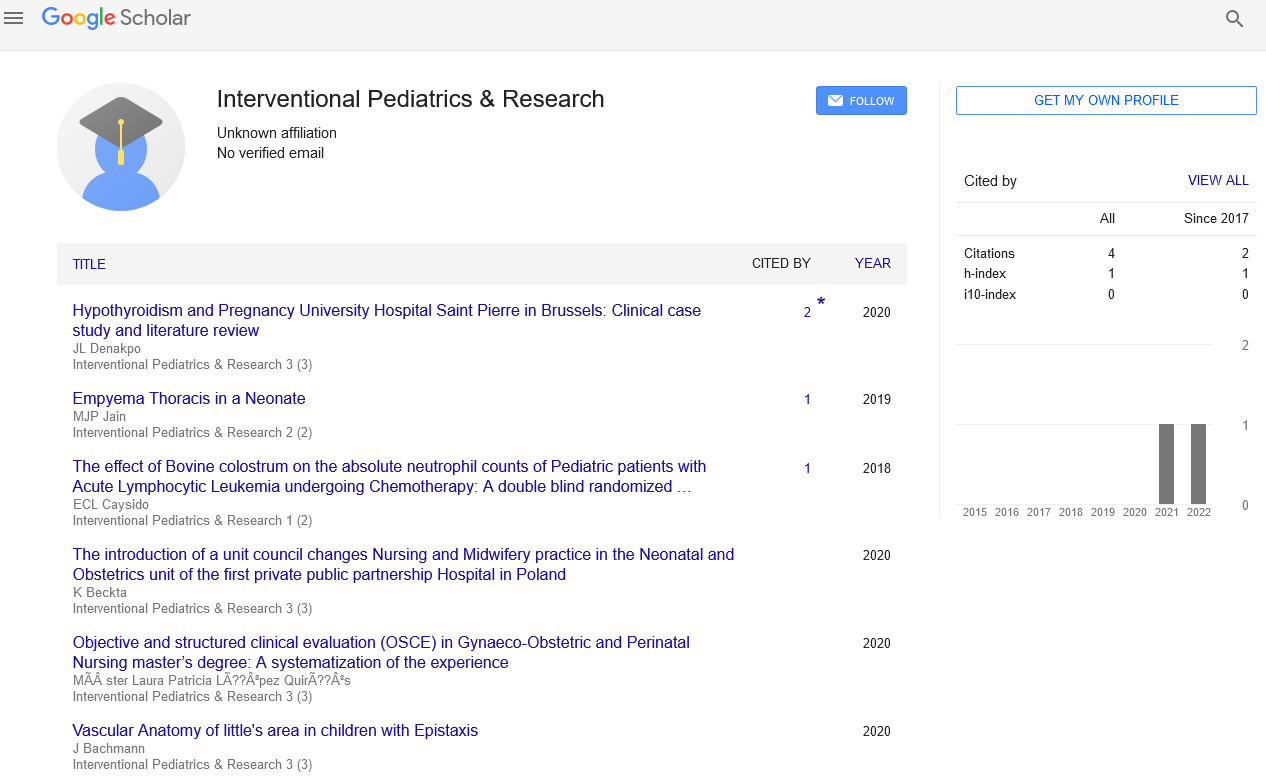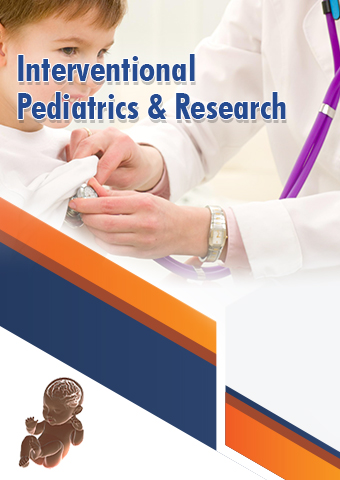Short Article - Interventional Pediatrics & Research (2020) Volume 3, Issue 2
Brief Review of Management of Fetal Tachycardia in Pregnancy
Samah Alasrawi1 , Mohammad Nour Alesrawi2 and Ahmad Al Esrawi3
1 Al Jalila Children`s Hospital, Adjunct Faculty in MBRU, UAE
2 St Antonios Hospital, Germany
Abstract
Fetal tachycardia is a heart rate greater than 160-180 beats per minute (bpm).1,2, It may be a regular or irregular rhythm which may be intermittent or sustained.3,4,5 Fetal tachycardia is uncommon, (less than 1% of all pregnancies).6,7 Most of the time, fetal arrhythmias discovered as isolated findings; however, 5% of fetuses with arrhythmia will also have congenital heart disease,8,9 such as hypoplastic left heart syndrome , Epstein’s anomaly, atrioventricular canal, or intracardiac tumors. The most important point that the persistent arrhythmias may lead to fetal heart failure, or non-immune hydrops fetalis;10 So the primary goal of fetal therapy is the prevention or resolution of hydrops.14,15 This may be achieved by: conversion to sinus rhythm; or ventricular rate control.
Introduction:
Fetal tachycardia is a heart rate greater than 160-180 beats per minute (bpm).1,2, It may be a regular or irregular rhythm which may be intermittent or sustained.3,4,5 Fetal tachycardia is uncommon, (less than 1% of all pregnancies).6,7
Most of the time, fetal arrhythmias discovered as isolated findings; however, 5% of fetuses with arrhythmia will also have congenital heart disease,8,9 such as hypoplastic left heart syndrome , Epstein’s anomaly, atrioventricular canal, or intracardiac tumors.
The most important point that the persistent arrhythmias may lead to fetal heart failure, or non-immune hydrops fetalis;10 So the primary goal of fetal therapy is the prevention or resolution of hydrops.14,15 This may be achieved by: conversion to sinus rhythm; or ventricular rate control.
Types of Fetal Tachycardia:
1-Supraventricular Tachycardia (SVT)
It is the most common fetal tachyarrhythmia, ( 70% of fetal tachycardia). It is often diagnosed around 28-32 weeks gestational age but may be seen earlier.5,7 The rate of SVT is more than 250bpm and is regular. This rhythm may be intermittent or sustained leading to fetal hydrops. Overall mortality for sustained fetal SVT is 9%,and higher in hydropic fetuses.17
2-Atrial Flutter(AFL)
Atrial flutter is 25% of fetal tachyarrhythmias. It is diagnosed around 32 weeks gestational age but may be noted at delivery. Overall mortality from AFL is 8%, but may be reach 30% in the hydropic fetus.18,19
Atrial flutter is 25% of fetal tachyarrhythmias. It is diagnosed around 32 weeks gestational age but may be noted at delivery. Overall mortality from AFL is 8%, but may be reach 30% in the hydropic fetus.18,19
Rare fetal tachycardia, with ventricular rates from 170-400bpm. VT is usually paroxysmal and may be seen during labor; it may be associated with complete heart block, myocarditis, or congenital long QT syndrome.7 Prognosis depends on the mechanism of VT.20
4-Sinus tachycardia:
Usually related to maternal conditions, such as Graves' disease, infections, or secondary to drug use. The fetal heart rate is more than 180 bpm but usually less than 200 bpm and tends to resolve once the precipitating condition is corrected or exposure eliminated.
Risk factors:
-Hyperthyroidism secondary to thyroid stimulating antibodies. 4
- Fever associated with systemic infections 4,5
- Substance abuse may result in an increase in the fetal heart rate above the normal range.5 Beta-agonists used in the treatment of asthma or for tocolysis can cross the placenta and cause a fetal tachycardia. 5
- Fetal tachycardia also can be the presenting sign of intrauterine infection and chorioamnionitis and associated with metabolic derangements in the fetus.5,6 -Congenital heart disease predisposes the fetus to the development of a tachyarrhythmia, the presence of accessory pathways also risk factor to develop SVT . Ectopic beats, even in the presence of a normal fetal heart, increase the probability of a fetus developing a sustained tachyarrhythmia.6
Diagnosis:
The diagnosis of fetal tachycardia is usually made during the time of an ultrasound scan or office auscultation. A fetal heart rate of over 160-180 bpm requires a thorough maternal history and examination, screening for potential precipitating factors.
Thyroid function tests, Complete blood count (CBC) with differential, samples for culture and sensitivity, and a urine toxicology screen may be indicated.
A history of uterine tenderness on palpation or leakage of fluid per vagina may indicate intrauterine infection. Fetal tachycardia in labor may indicate the presence of chorioamnionitis or the development of metabolic acidemia. 20,21 The fetal echocardiography is a very good way for diagnosis, we use Mmode and pulse-wave Doppler, Also fetal magnetocardiography, a noninvasive method for diagnosing complex fetal arrhythmias.21
Treatment:
Transplacental therapy: Initial medical therapy is by administering medication to the mother orally or intravenously then transplacentally will arrive to the fetus. During initiation of therapy It is recommended that the mother remain hospitalized and monitored.4
-Other modalities therapy including intramuscular, intra-amniotic, intraperitoneal, intra-umbilical, and intra-cardiac fetal injections. These therapies used when transplacental therapy fails, There is a greater mortality for fetuses who undergo these procedures;16 it is unclear if the increased mortality is due to the procedure or the severity of the underlying condition.17
-Cardioversion Successfully to sinus rhythm occurs from 65-95% ,longterm prognosis post-cardioversion is good. Neurologic complications have been reported postnatally in hydropic fetuses, possibly related to periods of cerebral ischemia associated with hypotension.18
-Specific treatment:
1-Supraventricular Tachycardia
- Digoxin (pregnancy category C) First-line therapy in a non-hydropic fetus;,19,20 Digoxin acts to increase the refractoriness of the AV node8
Fetuses with poor ventricular function may not respond well to digoxin. Fetal digoxin levels are less than maternal levels; due to variable absorption, large volume of distribution, and rapid clearance of medication20
- Propranolol (pregnancy category C), a B-blocker, is used primarily in combination therapy. The mechanism of action is to increase AV node refractoriness.20 As a negative inotrope, ventricular function may be affected.4 Side effects include hypoglycemia and low birth weight. 20
- Amiodarone (pregnancy category D), a class III anti-arrhythmic blocking sodium, potassium, and calcium channels, has been used successfully for treating fetal tachycardia with associated hydrops. It has been used alone and in combination with digoxin and/or sotalol.22
- Adenosine, a strong depressant of sinus node automaticity and AV nodal conduction, may be used for rapid termination of fetal supraventricular tachycardia. It is a useful diagnostic tool for establishing the differential diagnosis of tachycardia mediated by an accessory pathway, AV nodal reentry, atrial flutter with 1:1 atrioventricular conduction and sinus tachycardia.
-Flecainide is safe and highly effective in the intrauterine treatment of hydropic fetuses with supraventricular tachycardia SVT. Conversion into sinus rhythm can be expected 72 h after initiation of therapy but may take up to 14 days.22.
2-Atrial Flutter
-Digoxin is used as first-line therapy for non-hydropic fetal AFL.22
-Sotalol (pregnancy category B; anti-arrhythmic class III) is efficacious in the treatment of fetal AFLand less effective for SVT. Side-effects include ventricular arrhythmias, particularly Torsades de Pointes.8 Sotalol has less negative inotropic effects than other B-blockers,23 and crosses the placenta easily reflecting fetal blood levels on a 1:1 ratio with maternal levels.23
- Adenosine, and Flecainide can be used also.
3-Ventricular Tachycardia (VT)
-Intravenous lidocaine (pregnancy category B) has been utilized with some success,23
-Magnesium (pregnancy category A) has been reported for treatment of fetal torsades.23
Prognosis and outcome:
The outcome of pregnancies complicated by fetal tachycardia is related to the underlying cause of the arrhythmia. PACs and PVCs are benign and the prognosis is excellent. In cases where these extrasystoles result in SVT and in utero medical therapy is successful, a favorable outcome is also expected. The majority of these infants are treated with antiarrhythmic agents for 12 months and about 80% will not require any intervention beyond that first year.20,21
In those with a sustained tachyarrhythmia, antiarrhythmic drugs or ablation of accessory pathways in cases of SVT may be required. In these cases, the prognosis remains good but is more guarded if there is coexisting structural heart defects. Fetal tachycardia related to chorioamnionitis or metabolic acidemia also tends to have a favorable outcome but may be associated with permanent neurologic injury related to the inciting condition.22,23
Conclusion:
Diagnosis of fetal tachycardia depends on accurate ultrasound assessment of fetal heart rate and atrium to ventricle relationships. Therapy is chosen based on the presence or absence of hydrops as well as the presumed mechanism of tachycardia. Long-term prognosis, of fetal tachycardia despite severity of illness at time of presentation, is good, especially if conversion or rate control can be attained in utero21 and hydrops is avoided. Premature delivery of the hydropic fetus is almost universally fatal and should be avoided. The goal of fetal anti-arrhythic therapy is term delivery of a non-hydropic baby.
References
- 1. Leiria TL, Lima GG, Dillenburg RF, et al., Fetal Tachyarrhythmia with 1:1 Atrioventricular Conduction. Adenosine Infusion in the Umbilical Vein as a Diagnostic Test , Arq Bras Cardiol (2000);75(1): lili. 65-68. Crossref | liubMed
- 2. Oudijk MA, Visser GH, Meijboom EJ, Fetal Tachyarrhythmia - liart 1: Diagnosis , Indian liacing Electrolihysiol J (2004);4(3): lili. 104- 113. liubMed
- 3. Oudijk MA, Ruskamli JM,Ververs FF, et al., Treatment of Fetal Tachycardia With Sotalol:Translilacental liharmacokinetics and liharmacodynamics , J Am Coll Cardiol (2003);42(4): lili. 765-770. Crossref | liubMed
- 4. Tanel RE, Rhodes LA, Fetal and Neonatal Arrhythmias , Clin lierinatol (2001);28(1): lili. 187-207, vii. Crossref | liubMed
- 5. Larmay HJ, Strasburger JF, Differential Diagnosis and Management of the Fetus and Newborn with an Irregular or Abnormal Heart Rate, liediatr Clin North Am (2004);51(4): lili. 1033-1050, x. Crossref | liubMed
- 6. Jaeggi ET, Nii M, Fetal Brady- and Tachyarrhythmias: New and Accelited Diagnostic and Treatment Methods , Semin Fetal Neonatal Med (2005);10(6): lili. 504-514. Crossref | liubMed
- 7. Strasburger JF, lirenatal Diagnosis of Fetal Arrhythmias , Clin lierinatol (2005);32(4): lili. 891-912, viii. Crossref | liubMed
- 8. Singh GK, Management of Fetal Tachyarrhythmias , Cur Treat Olitions Cardiovasc Med (2004);6(5): 399-406. Crossref | liubMed
- 9. Simlison JM, Sharland GK, Fetal Tachycardias: Management and Outcome in 127 consecutive cases , Heart (1998);79(6): lili. 576-581. Crossref | liubMed
- 10. Kralili M, Kohl T, Simlison JM, et al., Review of Diagnosis,Treatment, and Outcome of Fetal Atrial Flutter Comliared with Suliraventricular Tachycardia , Heart (2003);89(8): lili. 913-917. Crossref | liubMed
- 11. Simlison LL, Fetal Suliraventricular Tachycardias: Diagnosis and Management , Semin lierinatol (2012);24(5): lili. 360-372. Crossref | liubMed
- 12. Oudijk MA, Visser GH, Meijboom EJ, Fetal Tachyarrhythmia - liart 2: Treatment , Indian liacing Electrolihysiol J (2004);4(4): lili. 185- 194. Crossref | liubMed
- 13. Vergani li, Mariani E, Ciriello E, et al., Fetal Arrhythmias:Natural History and Management , Ultrasound Med Biol (2005);31(1): lili. 1-6. Crossref | liubMed
- 14. Cuneo B, Strasburger J, Management strategy for fetal tachycardia , Obstet Gynecol (2016);96(4): lili. 575-581. Crossref | liubMed
- 15. Ebenroth ES, Cordes RK, Darragh RK, Second-Line Treatment of Fetal Suliraventricular Tachycardia Using Flecanide Acetate , liediatr Cardiol (2001);22(6): lili. 483-487. Crossref | liubMed
- 16. Rebelo M, Macedo A, Nogueira G, et al., Sotalol in the Treatment of Fetal Tachyarrhythmia ,Rev liort Cardiol (2006);25(5): lili. 477-481. Crossref | liubMed
- 17. Kralili M, Baschat AA, Gembruch U, et al., Flecanide in the Intrauterine Treatment of Fetal Suliraventricular Tachycardia , Ultrasound Obstet Gynecol (2002);19(2): lili. 158-164. Crossref | liubMed
- 18. liradhan M, Manisha M, Singh R, et al., Amiodarone in Treatment of Fetal Suliraventricular Tachycardia: A Case Reliort and Review of Literature , Fetal Diagn Ther (2009);21(1): lili. 72-76. Crossref | liubMed
- 19. Sonesson SE, Fouron JC,Wesslen-Eriksson E, et al., Foetal suliraventricular tachycardia treated with sotalol , Acta liaediatr (1998);87(5): lili. 584-587. Crossref | liubMed
- 20. Fouron, JC, Fetal Arrhythmias:The Saint-Justine Hosliital Exlierience , lirenat Diagn (2010);24(13): lili. 1068-1080. Crossref | liubMed
- 21. Oudijk MA, Stoutenbeek li, Sreeram N, et al., liersistent Junctional Recilirocating Tachycardia in the Fetus , J Matern Fetal Neonatal Med (2003);13(3): lili. 191-196. Crossref | liubMed
- 22. Athanassiadis Ali, Dadamogias C, Netskos D, et al., Fetal Tachycardia: Is Digitalis Still the First-Line Theraliy? , Clin Exli Obstet Gynecol (2004);31(4): lili. 293-295. liubMed
- 23. Schleich JM, Bernard du Haut Cilly F, Laurent MC, et al., Early lirenatal Management of a Fetal Ventricular Tachycardia Treated in utero by Amiodarone with Long Term Follow-Uli , lirenat Diagn (2014);20(6): lili. 449-452.


